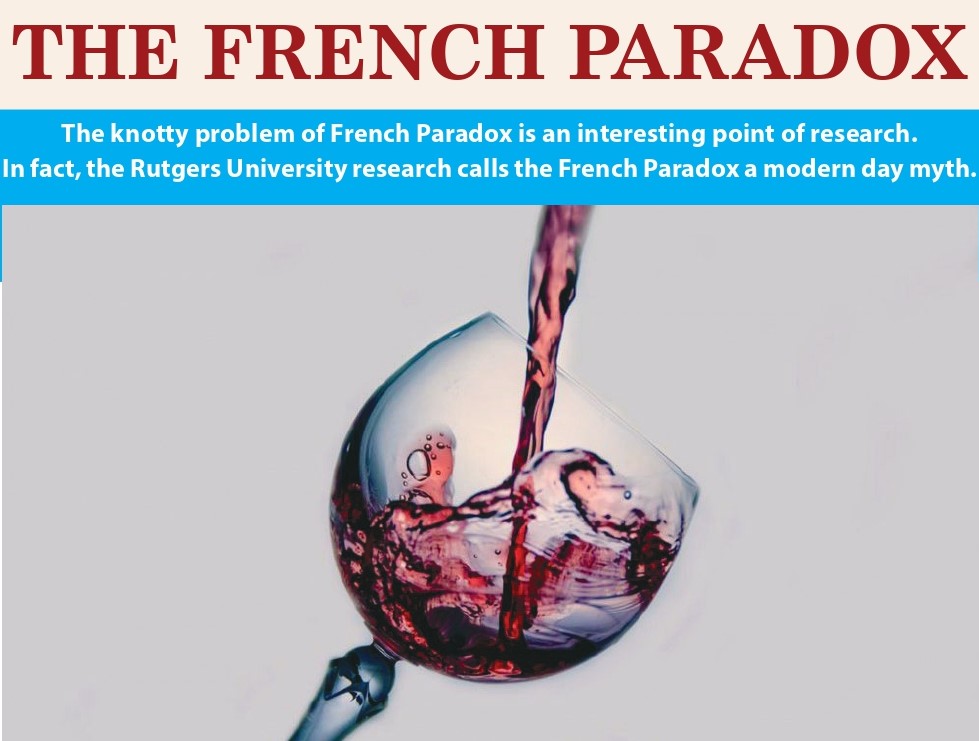The French Paradox refers to low incidence of heart disease and presence of healthy blood vessels in the wine loving French population.
The typical French cuisine is full of fats and considered generally unhealthy. However, the wine loving French, have low heart disease incidence. The heart protective benefit is attributed to polyphenols in wine. However, the French Paradox is also referred to as a myth since the polyphenol content of wine is not considered sufficient to give health benefits. Hence, the knotty problem of French Paradox is an interesting point of research.


Focus is on plant secondary metabolites
Human diet is more than vitamins, minerals, water, carbohydrates, fats and proteins. Plant based food provide the middle nutrients or mesonutrients – examples being polyphenols and carotenoids. Such plant compounds – mesonutrients largely belong to the category of secondary metabolites. Examples include tannins, resins, gums, alkaloids, and latex: these are substances produced by plants that confer non-reproduction related benefits to the plant. They are useful for self-defense of the plant and other plant chemical reactions or plant metabolism. Secondary metabolites are also secreted by non-plant life forms like microbes, fungi, and some animals. Various antibiotics discovered from fungi and bacteria are secondary metabolites. Penicillin and cephalosporin antibiotics are examples of secondary metabolites of specific relevant fungi. Many plant secondary metabolites are useful to humankind.
Polyphenols
Polyphenols are secondary metabolites that protect plants from ultraviolet radiation and plant disease causing agents. Examples of plant polyphenols include curcumin from turmeric, resveratrol from grapes, epicatechins (EGCG) from green tea, and chlorogenic acids from coffee (coffeeceuticals). Consumption of plant polyphenols protects from heart disease, keeps blood vessels healthy, and supports healthy immunity (self-defense of body). Concentrated polyphenols are offered in nutraceutical products to support well-being. Curcumin is one of the largest consumed nutraceutical polyphenol.
Carotenoids
Colored compounds in plants (particularly flowers) that help attract pollinating agents to the flowers are called carotenoids. Examples of carotenoids include beta carotene from carrots (pro vitamin A, which is converted to Vit. A inside the human body), lycopene from tomato skin, lutein from marigold flowers, and capsanthin from capsicum. While carotenoids in plants give colour to plants parts, it is interesting to note that carotenoids are highly beneficial to health of retina in the human eye.
Other secondary metabolites of plants
Tannins, gums, resins and alkaloids are some examples of other secondary metabolites from plants. Tannins are useful as they precipitate proteins and help in healing. Overall, the useful plant compounds have antioxidant benefits and supports human body’s immune system.
Controversial French paradox
Red wine manufactured from grapes contains resveratrol polyphenol. This super antioxidant reduces excess toxins called free radicals and hence, resveratrol is considered a molecule that helps increasing lifespan of humans. However, other research suggests that amount of resveratrol in wine is miniscule and insufficient to provide health promoting benefits. Further, alcohol consumption is associated with addiction and other deleterious health problems. In fact, the Rutgers University research calls the French Paradox a modern day myth.


Sunil S Chiplunkar M Pharm (Pharmacology) MBA (Marketing) PGDHRM (PhD)
VP – Business Development, Group Pharmaceuticals, Bangalore
E mail: 1969sunilchiplunkar@gmail.com
Mob: 6364578669











